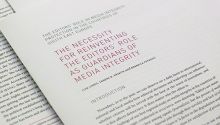The debate included broad conceptual issues, such as the role of non-profit media in society, but also concrete criteria that should be taken into consideration in the evaluation process.
As pointed out by representatives of the Ministry of Culture in charge of this program, nonprofit media are not included in the battle for advertisers and market competition (as commercial media are), nor do they have to justify their program schedule in an attempt to target a broad audience population and serve the tastes of many - such as public service media. However, the problem remains funding in a way that would enable a sustainable production process. Thus, it was proposed that, instead of financing projects – the usual way to finance different civil society organizations in contemporary societies – overheads and salaries would be provided for nonprofit media. This was accepted as positive; however, in the public debate, some voices claimed that this severely changes the position and role of civil society associations since they basically become employees of the state for a limited period of time, which then potentially jeopardizes their ‘watchdog’ role in relation to the state and political power.
The state viewed as oppressive is an argument that fits well into a post-socialist context in which state control is demonized while the withdrawal of the state and the invisible hand of the market are viewed as progressive and in accordance with democratic principles. In this context, the role of civil society organizations has grown, especially in areas such as health care, care for the elderly and education – traditionally in the domain of the welfare state. This process could be seen as dangerous, since expectations of civil society associations are high while the state is liberated from responsibility and at the same time criticized for its ineffectiveness, expensiveness and bureaucratic nature, which serves as an excuse for further budget cuts. It is constantly overlooked that state funding is actually public funding. While civil society associations are claimed to be the progressive forces in society, it is true that they constantly struggle with sustainability, insecure working conditions and a project-oriented logic, in which areas of relevance are mainly defined outside the field of civil society. These difficulties in the everyday practices of civil society associations limit their scope and range of action.
Key points
- Nonprofit media are not included in the battle for advertisers and market competition (as commercial media are), nor do they have to justify their program schedule in an attempt to target a broad audience population and serve the tastes of many - such as public service media.
- While civil society associations are claimed to be the progressive forces in society, it is true that they constantly struggle with sustainability, insecure working conditions and a project-oriented logic, in which areas of relevance are mainly defined outside the field of civil society.
- Despite the optimism and claim that civil society ensures a field of participation in which critical media can develop and make a difference, we should not forget to reclaim responsibility, at the same time, from the more powerful commercial and public service media.
The second line of debate moved in the direction of editorial democracy. It was argued that this should be an important criterion for funding, monitored through surveys or a similar method. However, the question is whether employees would admit to the lack of editorial democracy – since this would mean repercussions for the organization as a whole, in terms of further funding. This is surely one of the main obstacles in the journalist profession in general – every move that could jeopardize the position of journalists on an individual level (in terms of holding on to a working place) is blocked.
A third line of debate aimed at the influence media have in society – what is their reach, to what extent is it quoted in other media, what is the impact…? In this respect, the problem that emerges is: how can we measure social influence? How can we measure the role of media in self-organizing of citizens, their impact on public events, strategies of the government, etc. This is further complicated by the fact that different platforms needs to be approached differently - hits are applicable to online media, quotations are applicable only to online news media, radio stations – as an example – are much harder to access in this respect since they are accessible via online streaming as well – which complicates the matter further.
Some suggestions were extracted from the debate and a final list of differentially pondered criteria was established: pluralist representation of social actors (12); pluralism of topics (12); different approaches and angles to the subject matter (12); contribution to recognition of civic, political and social rights (12); fulfilling the ‘watchdog’ role in relation to the economic and political power (12); informative breadth of communication (8); contextual depth of communication (8); accuracy of information (12); differentiated journalist forms and genres (8); amount of own production (12); design and equipment (12); linguistic competence (8); reach, accessibility and influence (36); editorial democracy (8); and number of workers (8).
The evaluation process
The Expert Committee for Nonprofit Media (consisting of seven members) evaluated the proposals. Out of 90 accepted applications, 25 were selected for the second round and finally 14 media organizations (11 already established and 3 new) were chosen. The Committee was instructed to choose a proportion of three general, three specialized, already established media, and a minimum of three new media projects. They should also include different technological platforms
(2).
The nonprofit media outlet with the highest score was H-Alter – a web portal – recognized by all members of the Committee as of highest quality. Reviews
(3) written by the Committee
included recommendations for the respective media and, interestingly, the most frequent recommendation was that they should improve their presentation and the formats used – i.e. their visual identity. The insistence on form over content is somewhat peculiar for media that are primarily expected to be critically oriented – which is surely a matter of content.
Nada Zgrabljić, associate professor at the Centre for Croatian Studies and member of the Committee, expressed her opinion on the criteria in the following way:
It would perhaps be good if the criteria for newly established media were more clearly separated from the already established ones… For example [one criterion] was that media should monitor the sources of power; of course that H-Alter will get the highest possible score, but how should I know the position of someone new – I can only evaluate it based on what is written in the application (…) They should also make it more easily accessible to regional media…we wanted to include someone outside of Zagreb, but the truth is – they are not as strong, they do not have the capacities, so I think that they need some form of support.
The Croatian Journalist Association claimed that:
“The Ministry of Culture has made a step forward compared to previous similar tenders for public funding. It consists of the following: the Ministry initiated a broad public debate about its content; criteria for evaluation of media were known in advance and worked out in detail, as well as the number of points each of these criteria carries. The Committee was comprised of competent and independent members who took on the obligation to give written reviews for each media outlet. However, there were some weaknesses in the preparation and conduct of the tender, thus the Ministry of Culture should continue the public debate about it
(4).
What these weaknesses were was not stated in the article, but they did mention that the number of points given was not correlated with funds given to each media outlet.
Milan Živković assesses the process of evaluation in the following way:
Criteria always have to be modified, especially in the field of media which is constantly changing, so I think nobody is completely happy with the criteria we defined…it is a bit too early to evaluate the work of the Committee…this is a process that will occur…my first impression is that the members of the Committee did not lean on the criteria as much as I wish they had…as if they were not applied…it is too early to say whether the criteria were not applicable or the Committee did not apply them, or perhaps they were not well explained …most of the criteria are not quantifiable, so most of them necessarily include subjective estimations … This is something we will need to work on…
Final remark
The importance of this program is that nonprofit media are finally recognized by the main regulator as important actors in the media system in Croatia. This is surely a step forward in a context in which commercial interests dominate the field. However, despite the optimism and the claim that civil society ensures a field of participation in which critical media can develop and make a difference, we should not forget to, at the same time, reclaim responsibility from the more powerful commercial and public service media.
Interviewees
Živković, Milan, Head of the Media Department at the Ministry of Culture (2011 - ), Zagreb, September 2013
Zgrabljić, Nada, Associate Professor at the Centre for Croatian Studies and member of the Expert Committee for Nonprofit Media, Zagreb, October 2013
 New Media Regulation Supports Nonprofit Media
New Media Regulation Supports Nonprofit Media



